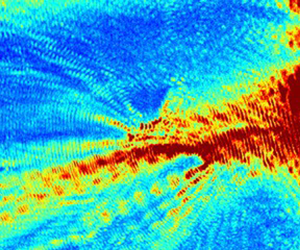Crossref Citations
This article has been cited by the following publications. This list is generated based on data provided by
Crossref.
Gomez, Bernabe
and
Kadri, Usama
2021.
Near real-time calculation of submarine fault properties using an inverse model of acoustic signals.
Applied Ocean Research,
Vol. 109,
Issue. ,
p.
102557.
Gomez, Bernabe
and
Kadri, Usama
2021.
Earthquake source characterization by machine learning algorithms applied to acoustic signals.
Scientific Reports,
Vol. 11,
Issue. 1,
Williams, Byron
and
Kadri, Usama
2023.
On the propagation of acoustic–gravity waves due to a slender rupture in an elastic seabed.
Journal of Fluid Mechanics,
Vol. 956,
Issue. ,
Gomez, Bernabe
and
Kadri, Usama
2023.
Numerical validation of an effective slender fault source solution for past tsunami scenarios.
Physics of Fluids,
Vol. 35,
Issue. 4,
Das, Santu
and
Meylan, Michael H.
2023.
Time-domain wave response of a compressible ocean due to an arbitrary ocean bottom motion.
Applied Mathematical Modelling,
Vol. 118,
Issue. ,
p.
832.
Das, Santu
and
Meylan, Michael H.
2024.
Effect of static compression on near-field tsunami waves: Three-dimensional solution.
European Journal of Mechanics - B/Fluids,
Vol. 106,
Issue. ,
p.
197.
Pethiyagoda, R.
Das, S.
and
Meylan, M. H.
2024.
Evolution of arbitrary temporal ocean floor motion-induced surface waves over a trench.
Physics of Fluids,
Vol. 36,
Issue. 12,
Das, Ritika
and
Das, Santu
2024.
Surface wave generation from a constant-slope-inducing asymmetric ocean floor motion: influence of compressible ocean.
Meccanica,
Vol. 59,
Issue. 9,
p.
1607.
Pethiyagoda, R.
Das, S.
Bonham, M.
and
Meylan, M. H.
2024.
Atmospheric pressure-induced three-dimensional surface wave propagation in the compressible ocean: Effect of static compression.
Physics of Fluids,
Vol. 36,
Issue. 9,
Dong, Qingchen
Zhao, Xin
Huang, Biao
and
Wang, Guoyu
2024.
Acoustic-gravity waves induced by vortices horizontally moving underwater.
Acta Mechanica Sinica,
Vol. 40,
Issue. 2,
Das, S.
Pethiyagoda, R.
and
Meylan, M. H.
2024.
Compressible ocean waves generated by sudden seabed rise near a step-type topography.
Physics of Fluids,
Vol. 36,
Issue. 10,
Dong, Qingchen
Zhao, Xin
Huang, Biao
and
Wang, Guoyu
2024.
Low-frequency acoustic-gravity wave emission generated by the vortex caused by a moving submerged cylinder.
Applied Ocean Research,
Vol. 147,
Issue. ,
p.
103990.
Kadri, Usama
Abdolali, Ali
and
Filimonov, Maxim
2025.
GREAT v1.0: Global Real-time Early Assessment of Tsunamis.
Geoscientific Model Development,
Vol. 18,
Issue. 11,
p.
3487.
Yang, Xiaoyan
Yang, Jie
and
Li, Xiaochen
2025.
Nonresonance, near resonance, and exact resonance in steady-state acoustic-gravity wave systems.
Physics of Fluids,
Vol. 37,
Issue. 7,
Suleimenov, Ibragim
Kadyrzhan, Aruzhan
Vitulyova, Yelizaveta
and
Shaltykova, Dina
2025.
The use of fiber optics for securing information during command transmission to UAV groups.
International Journal of Information Technology,
Williams, Byron
Abdolali, Ali
and
Kadri, Usama
2026.
Linear propagation of tsunami and acoustic–gravity waves on a sphere: Geometrical focusing and defocusing.
Wave Motion,
Vol. 140,
Issue. ,
p.
103643.



